| |
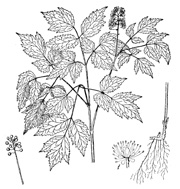 | Baneberry
Actaea spp.
Description: A perennial herb with large, attractive compound leaves and with scores of very small white flowers forming a cone-shaped cluster at the end of each leafy stem. The flowers are replaced by waxy red or white berries at summer’s end. The veins are often hairy on the back of the leaf.
Poisonous Part: All parts, especially roots and berries.
Symptoms: Increased pulse, dizziness, abdominal pains. Can cause poisoning in livestock. (Internal poisoning: an unnamed essential oil) |
 |  |
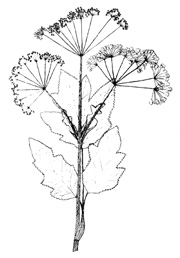 | Cow Parsnip
Heracleum lanatum
Description: A coarse perennial herb, 1 - 2 m tall with large hairy heart-shaped leaves. Small white flowers produced in large flat-topped clusters. The leaf stem is wide where it is attached to the main stem. The fruit is flat, winged and has dark lines (oil tubes). Grows in damp wooded areas. Note: May be confused with water parsnip or the highly toxic water hemlock.
Poisonous Part: Leaves.
Symptoms: Minor skin irritation to painful blistered inflammation in humans and livestock. (Dermatitis) |
 |  |
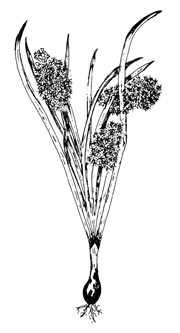 | Death Camas
Zygadenus spp.
Description: Two species of the bulbous death camas family grow in Alberta: the death camas (Z. gramineus) and the white camas (Z. elegans). The white camas grows in moist wooded places and is much less toxic than the highly toxic death camas, which commonly grows in plains and hillsides. Leaves are long, narrow and grass-like and gathered around the base of the stem. The tall stem is topped with a branched cluster of greenish to yellowish-white flowers. Both have glands at the base of the flowers.
Poisonous Part: All parts, especially leaves and bulbs.
Symptoms: Abdominal pain, nausea, vomiting, trembling, muscular weakness, difficult breathing, lowered body temperature, coma, death. Can cause poisoning in livestock. (Internal poisoning: alkaloids) |
 |  |
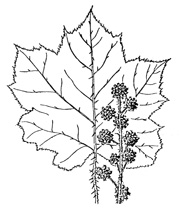 | Devil’s Club
Oplopanax horridum
Description: A coarse perennial shrub, 1 - 3 m high, occurring at scattered points along the east slope of the Rocky Mountains and also in the region of Lesser Slave Lake. It is distinguished by a single, thick stem armed with long, sharp, poisonous spines. Has an abundance of large maple-like leaves 5 - 7 lobes, 10 - 30 cm wide, covered with equally sharp spines along the underside. The minute greenish-white flowers are crowded in a dense cluster at the end of the stem and are replaced with a cluster of inedible red berries.
Poisonous Part: Spines along leaf stalk and leaf veins.
Symptoms: Painful wounds, swelling. (Dermatitis) |
 |  |
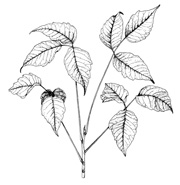 | Poison Ivy
Rhus radicans
Description: Poison ivy is a low (10 - 40 cm), somewhat sprawling shrub that grows in most ravines, shady woods and along river flats and streamsides, not common in Alberta. It is easily recognized by its compound leaves of three green drooping leaflets, 3 - 15 cm long. Has tight clusters of small yellowish-green flowers that are followed by showy bunches of dull, white, round, hard berries. In autumn, poison ivy leaves are a brilliant red.
Poisonous Part: All parts.
Symptoms: Burning, itching rash to broken blisters: in severe cases, the infection covers the entire body producing swelling and fever: death has occurred occasionally. (Dermatitis, internal poisoning: urushiol) |
 |  |
| Prince’s Pine
Chimaphila umbellata var. occidentalis
Description: A medium-sized shrub with slightly woody, many branched stems. Leaves are thick, shiny, evergreen and 2 - 7 cm long with fine serrations along most of the edge. Leaves are often in whorls of 3 - 8. Also produces white or purplish fragrant flowers in a cluster. Found mainly in southern Alberta, in dry woods.
Poisonous Part: Leaves and stems.
Symptoms: Minor skin irritation to painful blistered inflammation. (Dermatitis) |
 |  |
| Trillium
Trillium spp.
Description: A small, flowering, bulbous plant that produces all parts (leaves, petals and sepals) in groups of three. Flowers are 3 - 7.5 cm long, and their colour varies from white to pink depending on species. An uncommon native plant that grows in shady forests, sometimes grown as an ornamental.
Poisonous Part: Rootstocks.
Symptoms: Violent vomiting. (Internal poisoning) |
 |  |
|
|